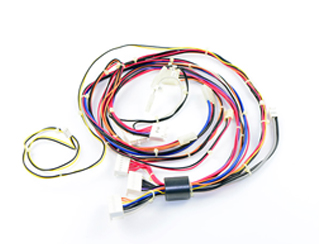A wire harness, often referred to as a cable harness or wiring assembly, is a systematic and integrated arrangement of cables within an insulating material. The purpose of the assembly is to transmit signals or electrical power. Cables are bundled together with straps, cable ties, cable ties, sleeves, electrical tape, conduit, or a combination of them. Wire harnesses simplify connections to larger assemblies by integrating cabling into a single unit for "drop-in" installation.
Reduced installation time: Many vehicles require miles of wiring to operate. The harness assembly process greatly simplifies the manufacture of these vehicles by integrating all of the required wires and cables into a single unit. The installation then becomes a simple matter of "plugging in" the harness, rather than running all the wires individually.
Safety and security: When wires and cables are bundled in a single harness, individual components are more secure against the adverse effects of vibration, abrasion, and moisture. Space is optimized and the risk of electrical shorts is reduced because the wires are constructed into non-bending bundles. The risk of electrical fires is also reduced when the wires are bundled in flame-retardant sleeves.

Wire Harness for Computers
The wire harness process is designed based on the geometric and electrical requirements of the equipment to be installed. Once the initial wire harness design is determined, schematics are used to create the assembly boards for the manufacturing instruments and harnesses. The assembly board, also known as the pinboard, is a full-size drawing of the wire harness showing all components and their locations. It is also used as a workbench for the wire harness.
Now, you may be starting to wonder what the difference is between an indoor and an outdoor harness, right? Well, it's completely understandable if you're starting to wonder if you need to clarify the differences between indoor and outdoor harnesses.
There are a number of factors to consider when selecting components for your custom wiring harness. One of them is the type of wire to be used. This means that there are significant differences in the types of wire used for indoor and outdoor harnesses.
For outdoor harnesses, the types of wire that can be used include a set of thick wires or even the use of cable assemblies. Cable assemblies are known to be durable, which allows them to last a long time.
In addition, the wires can withstand wear and tear, which is more cost-effective for you. Another importance of thick cables is that for outdoor use, the wires can cover long distances. These wires are insulated with thermoplastic rubber, vinyl, or shrink-wrapped thermoplastic.
Indoor use of wire harnesses requires the use of harnesses instead of cable assemblies. However, this is applicable when you are certain that the product will not be exposed to any unpleasant conditions.
Another advantage of using wire harnesses for indoor use is that they are cost-effective and allow power to be transmitted over long distances without incurring much resource cost. This is made easier by the size and capacity of the harness.
However, one thing is common both indoors and outdoors; that is, how to place the product.
Copyright © Xiamen New East Asia Electronic Enterprise Co. (NEAEE), Ltd. All Rights Reserved Sitemap |